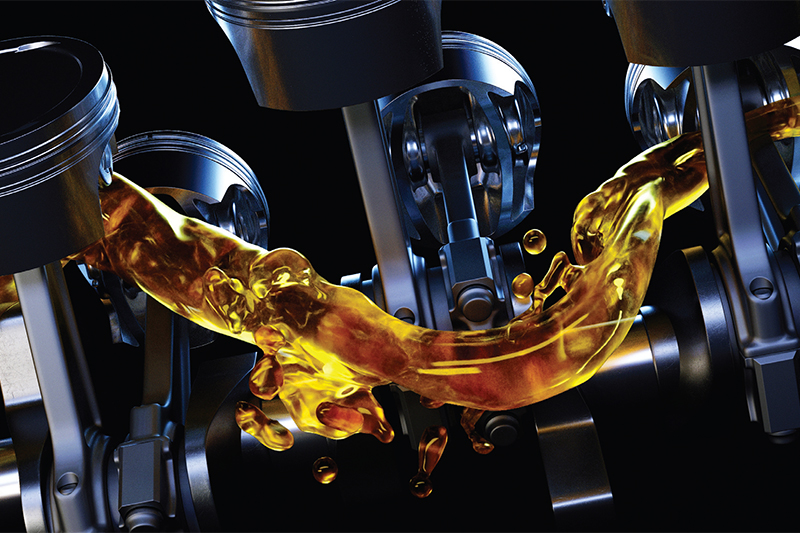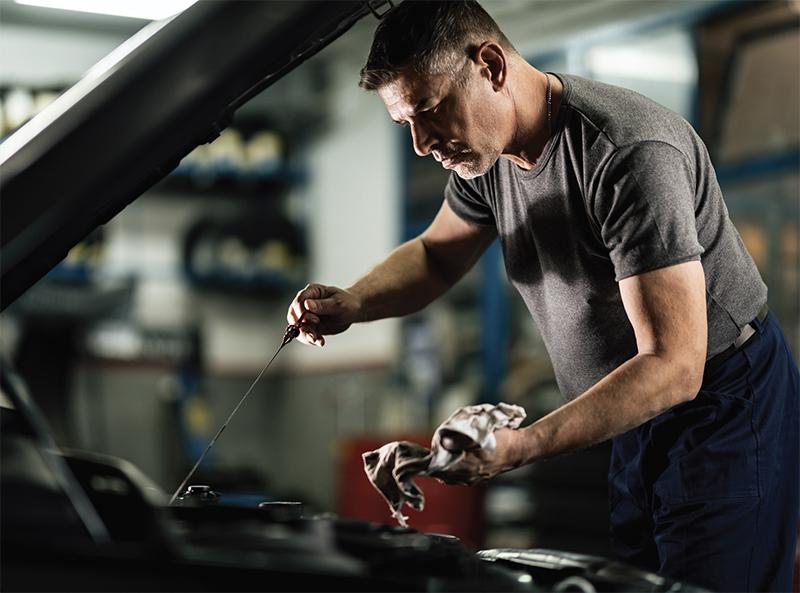
PMM ’s Kieran Nee dips into his address book in order to try and shine a light on the murky world of engine oils.
Where to begin with engine oils? All of you will be aware, of course, that the days of “one-size-fits-all” oils are long gone. But what separates one oil from another? Well, let’s start with the label – what are we being told and how do we read it?
Mike Bewsey, Chairman of the independent trade body, the Verification of Lubricant Specifications (VLS) explains: “Engine oil is classified by its viscosity and performance characteristics. Viscosity is indicated by an SAE rating, which defines its resistance to flow at a given temperature. The vast majority of products on the market are described as multigrades e.g. 5W-30, where the W or winter reference defines the low temperature viscosity and the latter the viscosity at 100˚C.”
Who decides what these grades actually mean? “Performance characteristics are defined by industry standards such as API, ACEA ratings and individual OEM specifications. API (American Petroleum Institute) ratings indicate an oil’s quality and are represented by a letter ‘S’ for gasoline (spark) and ‘C’ for diesel (compression) applications, for example, API SN or CK-4. ACEA standards (European Automobile Manufacturers Association), e.g. ACEA C2, are developed by the association of OEMs specifically tailored to the European market.”
Why, I’m sure you’re asking, must engine oils be so complex now compared to before? Well, a lot of it revolves around developing ever thinner oils. As Liqui Moly’s deputy head of the oil laboratory, Oliver Kuhn, describes: “Our task as an oil manufacturer is then to develop motor oils that are thin and still offer the required performance. This is due to car manufacturers and their efforts to further reduce vehicle emissions. The thinner a motor oil is, the less force the engine needs to apply to pump it. This reduces fuel consumption. The effect isn’t huge, but thin oil is one of many adjustments the auto makers make to increase the efficiency of their vehicles.”
A lot of responsibilities
So the main impetus behind oil development is a drive to make ever more efficient, and thus more environmentally friendly, vehicles.
This also saves fuel, a nice bonus. But it’s not as simple as all that. Other than efficiency, what are some of the pressures placed on modern oils? Morris Lubricants’ technology manager, Adrian Hill, points to some modern vehicle innovations: “Hybrid vehicles and engines with stop/start regimes pose challenges for the engine oil, where fuel and water dilution can lead to issues such as oil pump wear and bearing corrosion. Therefore, the engine oil is specifically designed to work within these demanding duty cycles.”
Smaller engines, of course another facet of the mission to eliminate emissions, is pinpointed as a key reason by Castrol: “The rise of engine downsizing in the 2000s and 2010s has resulted in smaller-displacement engines with forced induction, usually turbocharging.
“Modern engines are built to very different design philosophies, and to increasingly tight tolerances. An oil of a different specification to that required can block filters, poison catalysts, and even cause oil starvation that can contribute to engine damage.”
Meanwhile, Witham Motorsport points out the “more exotic metals and alloys in the manufacturing process” along with the fact that “service oil drain intervals are continuing to increase, from a few thousand miles to tens of thousands of miles.” With oils now having to cope with “increased combustion byproducts, unburnt fuel and water in the form of condensation being deposited within it while under higher extreme pressure and temperatures.”
So, all in all, the more ways vehicle manufacturers tackle the need for lower emissions, the harder engine oils need to work to maintain an equilibrium. But what is actually in these oils – what makes them so complex?
As Liqui Moly’s Oliver Kuhn outlines: “Motor oils consist of two main components: the base oil and the additive packages. In the past, the base oil was the most important performer in motor oil, but today it is the additive packages. Almost a third of modern oils consists of additive packages.”
According to Motul’s UK technical specialist Has Tahier, “these include VI improvers, anti-foam additives and anti-wear additives.”

I turned to Witham Motorsport for a blow-by-blow account of each of the most common additives:
Viscosity Modifiers – these allow lubricants to operate within a wide range of different operating temperatures.
Pour Point Depressants – these enhance the finished lubricants cold temperature performance.
Anti-Foaming – this technology lowers the surface tension in the lubricant allowing it to shed entrained air quickly.
Total Base Number (TBN) Boosters – designed to increase the lubricant’s ability to neutralise acidic compounds produced by the combustion of fuel within the internal combustion engine.
Anti-Wear additives – as simple as they sound.
Dispersants – This additive reduces deposits creating sludge or clumping together and blocking oilways.
Detergents – designed specifically to keep the internal components clean.
An electrified future
As I spoke to each company, I started to get a slight feeling of dread. Surely, I thought, they’ve all got January 1st 2030 circled in red on their calendar – the beginning of the end?
If ICE vehicles are no longer for sale, won’t these complex oils all designed ultimately to reduce emissions become somewhat pointless?
Castrol struck a cautious tone for the aftermarket: “The increase in the number of BEVs, HEVs, and PHEVs will lead to an increase in EV fluid consumption, particularly at factory fill point. However, in the long term, it will not offset the reduction in ICE fluids demand mainly due to the absence of engine oil in the BEV models.
“From an aftermarket perspective, the frequency of change for both transmission fluids and coolants/thermal is either low or fill for life and it’ll lead to a drop in aftermarket for fluids for BEVs. HEV and PHEVs still do have an engine and will require engine oil, though at lesser quantities than ICE vehicles. Having said that, there could be other avenues of maintenance that could increase such as servicing of brakes / brake maintenance.”
Morris’ Adrian was more confident: “It is important to realise that the lubricant industry is not just oil for petrol and diesel engines, it is about building blocks to help improve efficiencies, maintaining component life and increasing reliability. This philosophy continues with hybrid and electric vehicles where the lubricant industry is developing thermal management fluids for battery packs, as well as specialised lubricants for e-transmissions. Hybrid vehicles will still require engine and transmission lubricants and the lubricant industry’s development programmes will be fine-tuned accordingly to bring new technologies to market.”
As Witham rightfully points out, there will always be vehicle components that need lubrication. What’s more, the banning of new ICE vehicles might not have quite the desired effect legislators are hoping for: “The drive towards EVs is an interesting opportunity for lubricant blenders, and whilst EVs don’t use engine oils they do have axles and transmissions. There are already different ranges of these fluids finding their way onto the market. The other dynamic is the banning in many European countries of new internal combustion engine vehicles in the near future. This will by definition mean many older vehicles will remain on the roads longer creating a market for existing specifications far into the future. The classics of yesterday will remain classics but the cars we are driving now may also become classics of the future!”
What changes will aftermarket workshops need to put in place, then, in order to continue servicing EVs? Morris was succinct: “The attitude towards thermal management fluid maintenance and e-transmission maintenance will require exactly the same disciplines as with internal combustion engine vehicles. The main difference will be in the safety aspects of dealing with battery packs, where severe injury or even death may be the result of inadequate training.”
The lowest viscosity oil is currently 0W-8! Only specified for Japanese vehicles. Castrol shed some light on their role within the aftermarket: “As greater volumes of electric vehicles enter the aftermarket, more OEMs have asked us to make an advanced EV transmission fluid available to their workshop partners, to support ongoing repair and maintenance activity. While these fluids in some EVs are deemed ‘fill for life’, workshops need replacement product in the event of a repair and there can also be a requirement to change the product early to safeguard protection in certain use cases. Once we move to EVs, it is more likely that their maintenance will require specialists who can do the work on them, rather than DIY car enthusiasts (as is the case with ICE).”
Motul also emphasised that “EVs generate substantial amounts of heat that needs to be evacuated to prevent overheating.”
There is another, more urgent, pressure impacting on the oil industry this year. Russia’s invasion of Ukraine has disrupted an already volatile market. I asked Witham how this was affecting the lubricants industry’s ability to service the aftermarket.
“The global shortage of raw materials before war broke out in Ukraine has had a huge impact on all global sectors and the lubricants industry has been no different. The sanctions against Russia have had the most dramatic effect, putting increased strain on already tight global supply. This has meant that some oil companies are unable to supply finished products to customers. It has also meant pricing for base oils that are needed to manufacture lubricants in the first place has just seen unprecedented increases for several months with no outlook for a let up in the short term.”
What is the immediate effect that workshops will notice? “Prices have inevitably increased significantly over the past year. As the war in Ukraine continues and if global supplies are squeezed, we are unlikely to see significant reductions in the near future. However, if the war is resolved and Europe has a warm winter then a surplus would probably bring some prices down. The variables are numerous, complicated, and unpredictable.”
Conclusion
At the time of writing, it unfortunately feels like neither of those eventualities are likely, and it looks like the situation in UK workshops will remain tough. The events of recent years have been an unwelcome reminder that, despite our modern sense of comfort and security, we are ultimately subject to the pressures of global events. Oils have travelled far and wide before reaching your workshop, following, of course, a manufacturing process stretching back millions of years underground. No one product more neatly outlines the paradoxical challenges of the modern world: creating a cleaner planet in the midst of war and market turmoil – and it’s all happening right in your workshop. Happy pouring!









